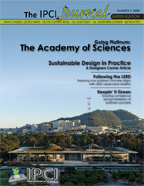Sustainable Design in Practice
An architects perspective on using polished concrete
As I researched and talked to colleagues about an article on our experience with polished concrete and sustainability I kept coming back to the material itself. Concrete gets a mixed review when analyzing its sustainability credentials, but it is a huge component in building construction today - making up over half of building materials used by mass. It certainly has environmental advantages including longevity and chemical inertness. For passive solar applications, concrete’s ability to function as a structural element while also providing thermal mass makes it a valuable material. But cement is among the most energy-intensive materials used in the construction industry and a major contributor to CO 2 in the atmosphere - some 12% of the industry’s global warming impacts by material. There are various ways to minimize its environmental effect such as reducing the quantity of concrete used in buildings and specifying ingredients such as fly ash in the mix*.
Polishing concrete as a finished floor surface, on the other hand, is a choice that is environmentally responsible on many levels. The most beneficial reason is that in most applications a structural concrete floor slab is needed anyway. Conventional practice with concrete floor slabs has been to add topping slabs, glue on resilient flooring materials (VCT, sheet vinyl, rubber, etc.), provide underlayment and carpeting, or build some other type of new floor system on top of the concrete. Polishing and hardening the concrete obviates the need for another floor material on top. A polished concrete floor will reduce the total quantity of materials used, helping to ‘dematerialize’ a project – a powerful concept in improving sustainability in the building industry.
At the Queens Museum of Art expansion, Grimshaw faced the typical challenge of a client with high ambitions and a tight budget. We wanted to bring natural sunlight and daylight into the heart of the museum with a design that would progressively filter and diffuse the light. To achieve this, surface properties were critical. Polished concrete is typically thought of as appropriate for schools, warehouses, big-box retail stores and industrial buildings rather than museums. We were intrigued by our clients’ vision. Far from the marble halls of an elite institution, our client envisioned a friendly museum attracting all members of society. The team thought that polished concrete had the potential to fit into that vision and provide the required range of reflectivity flexibility as the daylight design progressed, and most importantly, address the realities of the budget while achieving a beautiful finish.
As a design practice where sustainability is a core value, we were impressed as we dug deeper in sites such as www.buildinggreen.com, which further explained the environmental benefits of polished concrete compared to competing approaches. Polished and densified concrete floors (old or new) combine diamond stone-polishing technology with silicate chemical treatment to provide a significantly better alternative to film and wax coatings. Both epoxy and moisture-cured polyurethane film coatings have been used on concrete slab floors for a number of decades. These are relatively inexpensive. They achieve a hard, shiny epoxy or polyurethane surface that is resistant to most chemical attacks and stains, and effectively prevents dusting of the concrete surface. However, these are coatings and they deteriorate with wear and have to be reapplied periodically - as often as every five years.
Floor wax on concrete is even less expensive to apply and it also creates a smooth, shiny surface. But the wax wears through quickly and has to be reapplied. The old wax layers periodically have to be chemically stripped prior to the application of a new layer. Both the stripping and the waxing generate significant VOC emissions.
Polished concrete, on the other hand, is highly durable, nearly maintenance-free, noncombustible, and has no volatile organic compounds (VOCs). There are no VOCs, epoxies, polyurethanes, waxes, or strippers, and no caustic or acidic cleaning compounds needed. Indoor air quality is the beneficiary.
The cost of cleaning and its impacts on health and the environment was also a big consideration. For the average commercial building in the
Minimizing waste during the construction process is part of a sustainable approach. On the

